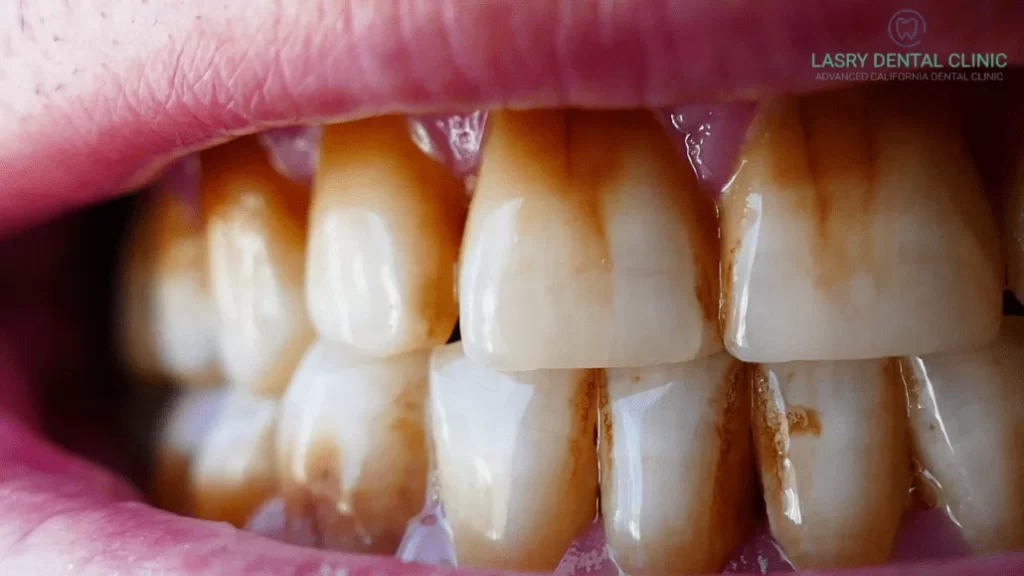Unsightly tooth stains can cause great embarrassment and keep people from smiling. So what causes tooth discoloration and how can you prevent it from happening to you?
The answer isn’t as simple as you think. No one’s teeth are perfectly white, and to some extent our teeth will become a bit duller as we age. But depending on your genetic makeup, everyone is born with a slightly different tooth shade, with some fairing better than others. Regardless, how you treat your teeth will greatly determine the outcome of their color.
What Causes A Tooth Stain?
Unfortunately, for those who suffer from teeth discoloration, teeth can appear yellow, brown or even grayish in color. Some may have overall discoloration while others have dark spots on their teeth.
When trying to determine where tooth discoloration comes from, take into consideration there are two types of tooth stains: extrinsic and intrinsic. Extrinsic stains are known as surface stains. These are caused when outside elements affect the surface of the tooth. Intrinsic stains result when the interior sections of the tooth have darkened.
The good news is you can prevent many of these stains! Once you understand what causes tooth discoloration, you’ll be better equipped to handle fighting off some of its culprits.
Extrinsic Staining
Food and Drink — Coffee, tea, soda and red wine can cause tooth stains when consumed over a long period of time. Berries, curries and soy sauce are just a few of the foods that stain teeth. Foods and drinks of extreme temperatures can also affect tooth color — the heat and cold open and close the pores in your teeth, allowing staining agents to attack them with greater force.
Smoking — Smoking can greatly discolor teeth. But chewing tobacco isn’t much safer — any tobacco product will have devastating effects on teeth.
Oral Hygiene — Generally speaking, bad oral habits will negatively affect your teeth’s health. Discoloration is just a minor side effect of inefficient dental care.
Intrinsic Staining
Drugs — Antibiotics such as tetracycline can cause discoloration in children whose teeth are still forming. Other drugs, including antihistamines, antipsychotic and antihypertensive medications may also cause staining. Some mouthwashes may also leave behind teeth discoloration.
Dental Fluorosis — Fluoride is incredibly important in preventing tooth decay. But too much fluoride can lead to dental fluorosis, a condition that causes white spots or lines on the teeth. Dental fluorosis only affects children whose permanent teeth are still forming beneath the gum line. But don’t start limiting fluoride quite yet — see a dentist to determine how much fluoride your child should be consuming.
Trauma — Chipped teeth or broken teeth can darken due to enamel damage or a dead nerve. This teeth discoloration is also possible if a tooth is not capped following major dental surgery, such as a root canal. If you have a single dark tooth, see a dentist to fix any underlying dental problems.
Dental Fillings — Tooth decay is often evident in brown or black spots on teeth. On that note, a large amalgam tooth filling can also cause outlying enamel to appear gray.
Genetics and Aging — This falls under both categories. Some people are just born with tooth discoloration, and unfortunately most people’s teeth will not age gracefully. Everyday wear and tear will contribute to tooth discoloration over time.
How to Treat and Prevent Tooth Stains
Although some tooth discoloration is inevitable, there are ways to prevent it. Avoid consuming foods and drinks that contribute to teeth discoloration on a regular basis. Don’t smoke or chew tobacco, and practice excellent oral hygiene. Ask your doctor or pharmacist if any medications you’re taking result in tooth staining as a side effect. And have dental X-rays taken during your exams to check for any signs of trauma.
If you already have tooth discoloration and brushing doesn’t seem to work, there are ways to help you get rid of it. Thanks to cosmetic dentistry, there are several options for removing or covering tooth stains:
Ultrasonic Cleaning — Now a standard form of professional dental cleaning, ultrasonic vibrations are used to remove some extrinsic stains caused by a buildup of calculus. Although it won’t change the color of your teeth, an ultrasonic dental cleaning can be performed during regular dental visits to limit tooth stains.
Teeth Whitening — To completely lighten your teeth, you can try teeth whitening. Your dentist can provide you with teeth whitening trays to wear at home. These trays are formed from a mold of your teeth, and hold a gel containing the active agent peroxide. Worn daily, at-home bleaching trays can whiten teeth in 1-2 weeks.
Laser Teeth Whitening — Like teeth whitening, laser teeth whitening uses a peroxide gel to lighten teeth. But laser teeth whitening is done in the dental office in about an hour. After the gel is applied to teeth, a laser uses heat to activate the teeth whitening agents, with excellent results in a shorter amount of time.
Dental Veneers — In the cases where whitening just won’t work, veneers can completely cover tooth discoloration. Dental veneers are wafer-like tooth coverings often made of porcelain that are cemented onto teeth. Porcelain dental veneers are also perfect for broken teeth or slightly crooked teeth.
Despite some reported sensitivity, all of these procedures are safe and effective in treating teeth discoloration when administered by a dental professional. Over-the-counter bleaching agents are also available, with varied results. Some whitening toothpastes may help, but they will not be able to remove intrinsic stains. Regardless, you don’t want to spend all that money fixing your teeth just to go back to bad habits — proper oral hygiene is needed to maintain the results of your cosmetic dental procedure.

